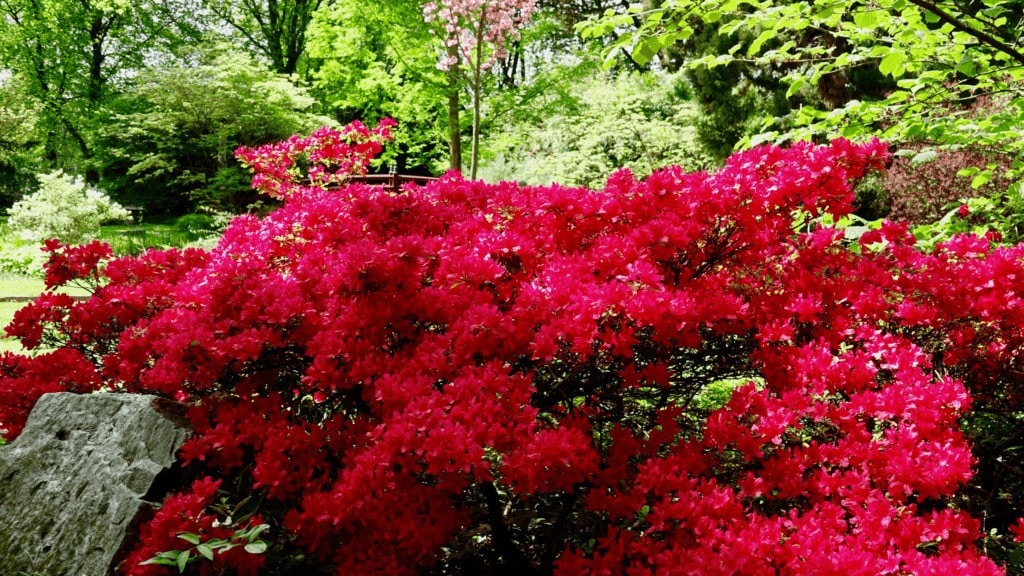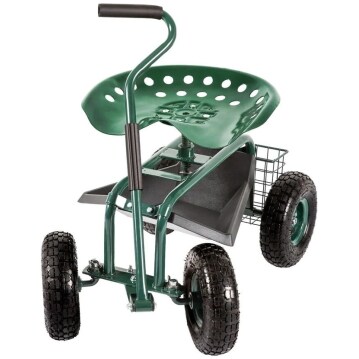
Azalea Japonica (Rhododendron Azaleastrum sect. Tsususi) is an evergreen, woody shrub that produces a large number of beautiful flowers, the color and size of which depends on the variety. It’s cold tolerant and grows well in shady areas, making it suitable for almost all outdoor gardens. Left unattended and given ideal growing conditions, many varieties of azalea can reach a height of up to 2 meters (6 ft.).
However, it is a very slow growing plant and with some infrequent pruning, it’s easy to maintain it as a compact bush that will get completely covered in beautiful flowers during the spring. The plant can even be grown as a tiny bonsai tree, which we’ll briefly discuss later in this article.
Azalea japonica is part of the Rhododendron genus, which has a complex and sometimes even confusing taxonomy. Rhododendrons are divided not only in genera (the plural of genus), but also in sub-genera, sections and sub-sections. Azalea japonica in particular refers to Rhododendron Azaleastrum sect. Tsususi.
Browse our Affiliate Products
Unsurprisingly, it is native to Japan, where it commonly grows in shady areas under big trees. The name Azalea japonica doesn’t refer to a certain variety that flowers in a particular color or reaches a particular size. Instead, the species has many different varieties and hybrids, some of which can only grow to 1-2 ft in height, making them suitable for smaller outdoor gardens.
It’s worth noting that all azaleas are strictly ornamental plants, grown only for their beauty – all parts of the plant are poisonous and contain Grayanotoxin. The toxin is also contained in the pollen of the plant, which in rare cases may ultimately result in it being turned into poisonous honey.
How to Grow & Care for Azalea Japonica

Azalea Japonica doesn’t require much care. In fact, there are only two ways to unintentionally kill or injure this plant – forgetting to water it for a long period of time and planting it in a location with too much direct sunlight.
Keep in mind that this is a slow-growing plant that can take up to 10 years before it reaches its full size. Because of this, the most practical way to plant your garden with azaleas is to purchase mature plants from a nursery and directly plant them in suitable locations.
However, if you have the patience, azaleas can certainly be grown from a cutting or even from seed.
Amazon offers some great choices on Azaleas as shown Below.
Light Requirements
Just like all azaleas, azalea japanica is a slow-growing, shade-loving plant. When it comes to most garden plants, the more sun you can provide, the faster they will grow. This is not the case with azaleas – they have a relatively weak root system that doesn’t reach very deep and can’t transport a lot of water.
Planting them in direct sunlight will only result in heat stress, leaf spots and eventual death. The pretty flowers are the first to fall off when the plant is stressed by too much heat, which is also why most azaleas prefer to flower during spring, when the temperatures are lower.
Temperature
Azaleas are evergreen shrubs and have no problems surviving very cold, sub-freezing temperatures. Even temperatures as low as 3F (-15C) will not harm the plant. However, some varieties may start losing their leaves when the temperatures drop significantly below freezing for long periods of time.
Still, this won’t actually hurt the plant – once the temperatures pick up again, it will start growing new foliage. Azaleas are most often planted directly outside, in raised beds made out of suitable, acidic soil. This is the case even in colder European countries.
For caring for plants during the winter and zone types, check out our article here. How Do I Care for My Plants in the Winter?
Soil
Azalea species all require an acidic soil. Plant species that have this requirement are often collectively called ‘heath plants’. Soil acidity can be achieved in several ways. Adding 1/3 peat moss to your soil mix is probably the simplest way.
Another possibility is to use Ericaceous compost – this is a compost that is naturally acidic and has no alkaline additives like lime added to it during the composting process. The name comes from the plant family Ericaceae, which azaleas are also a part of.
If you plant azaleas in an alkaline soil, you will run into various problems, like poor growth and nutrient deficiencies – the roots of this plant require low enough pH in order to successfully absorb micro-nutrients like iron. Planted in a rich soil, azaleas don’t require any fertilization.
For more information about soils, check out our article here.
What Are The BEST Potting Soils for Every Type of Plant?
Water Needs
Azalea japonica doesn’t posses a deep-reaching and powerful root system – it likes a soil that is constantly moist, but not waterlogged.
Watering every few days is best. Forgetting to water your azalea is one of the easiest ways to unintentionally kill the plant, or at the very least lose a large amount of leaves and flowers.
Where to Plant Azalea Japonica
Azalea has a shallow root structure, which makes it perfect for planting in a raised bed, made out of the acidic soil it requires. It can also be grown in containers, which don’t need to be very large, but still need to be sizable enough to hold some moisture.
Planting azalea in very shallow containers will ensure that it needs constant watering, which can be a hassle. As a general rule, use a pot that is at least 8 inches deep. In raised beds, azalea can be grown in combination with other plants in the Ericaceae family, especially other Rhododendrons, all of which prefer the same type of acidic soil.
If your interested in constructing your own raised bed, check out our article below.
Blooming Behavior of Azalea Japonica

Azalea japonica blooms during the spring. The actual blooming period depends on the climate of your locale and on the specific variety. In certain mild climates, certain varieties can have their blooming period extended throughout the summer.
The flowers of spring-blooming Japanese azalea varieties will quickly wilt and fall off when the temperatures get too high. The ideal blooming temperature of Azalea japonica is around 60F (15C). It’s important to note that there are re-blooming or multi-season blooming varieties of Japanese azalea.
Just as the name suggests, those can bloom for much longer than just the spring and a few varieties can even keep flowering year-round if the location is suitable enough – which usually are USDA zones 5 through 8.
How to Propagate Azalea Japonica
Azalea is easily propagated from stem cuttings. However, it’s a slow grower, so don’t expect the cutting to grow into a full-sized shrub for at least a few years.
The process of rooting an azalea cutting is the same one used for all other woody shrubs. It involves taking a 10-inch cutting (but any size will work), removing the leaves from the bottom half, dipping the cut end in some rooting hormone powder (optional, but highly recommended) and then sticking the cutting in a rooting medium, while providing a humidity dome to prevent wilting.
Any rooting medium can work and the cutting can even be rooted in a glass of water. A mixture of peat moss and perlite is often used. Once the cutting develops its root system, which can take a few months, it can be planted outside.
How Big Does Azalea Japonica Get and Is Pruning Necessary?

As we already mentioned, azalea grows slowly. Depending on the variety, it can reach a height of 6-7 ft. (2 meters), but if you’re starting from a cutting, this can take up to 10 years. Many of the most popular garden-grown varieties are special hybrids that do not grow higher than 2-3 feet.
Pruning is not necessary, neither for optimal growth, nor for flowering, but you can certainly cut back the shrub and shape it to your liking. This is best done immediately after the flowering period ends.
How Difficult Is It to Grow Azalea Japonica As a Bonsai?

The Bonsai art originates from Japan, so it’s not surprising that the Japanese azalea is one of the species of shrubs most commonly used for that purpose.
The Satsuki variety of azalea is a particularly common bonsai plant – the end result is a beautiful little tree that gets covered with countless small pink or purple flowers when it blooms. Creating a bonsai out of an azalea plant can be easy – all it takes is purchasing a large, mature specimen which is then cut back and planted in a small suitable container.
If you’re able to find a suitably shaped plant in your local nursery, you can make your own azalea bonsai in less than 2 hours.
Varieties and Colors
There are many different varieties and hybrids that are all classified as Japanese azalea. Azalea has been cultivated for its beauty for hundreds of years – at least for 200 years in Europe.
During this time, a lot of different colors have been isolated and crossed with each other to produce new varieties with new interesting features. Here are three popular varieties:

Girard’s Rose: A very popular variety of Japanese azalea, commonly cultivated throughout the US. As the name suggests, it has deep red flowers, just like a red rose. Unlike many other azalea varieties, it produces large flowers that can reach up to 3 inches in diameter. This is a low-growing variety of azalea that doesn’t grow taller than around 2 feet.

Encore: This is a trademarked variety of re-blooming, multi-season azalea that has sub-varieties of many different colors. Unlike many other azalea varieties that bloom only once during the spring, it can keep forming new flowers from spring to fall or even all throughout the year, depending on the local climate.

Satsuki: A late-spring blooming variety, native to the mountain regions of Japan. It’s one of the most commonly cultivated varieties throughout Asia and is particularly suitable for being grown as a bonsai tree, because of its bushy, tree-like structure.
For more in depth information on Azaleas click the link below. wikipedia.org/wiki/Azalea
Not all azalea varieties have been given a name and plant nurseries may carry a large number of very different looking, unnamed varieties, suitable for different purposes, climates and gardens. Since azaleas are usually purchased as mature plants, its easy to select the combination of varieties and colors you like best.









